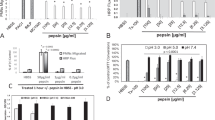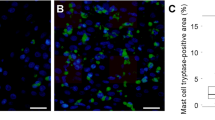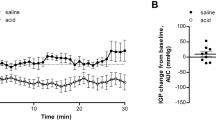Abstract
Studies on the pathophysiology of reflux esophagitis have focused on the associated motility and/or structural abnormalities, with relatively little attention directed to inflammatory mediators involved in the acid-induced mucosal injury. Mast cells line the subepithelial lamina propria in both humans and the opossum model, and are ideally positioned to respond to luminal agents that cross the mucosal barrier. To determine whether certain mast cell mediators are involved in acid-induced mucosal injury, epithelial injury scores following 60 min of luminal perfusion of the opossum esophagus with 100 mM HCl were compared in the presence and absence of two different mast cell stabilizers (disodium cromoglycate and doxantrazole) or the selective platelet-activating factor antagonist TCV-309. In control animals acid perfusion caused release of PAF and significant epithelial injury, characterized by epithelial sloughing and cleft formation. This injury was unaffected by pretreatment with disodium cromoglycate or doxantrazole but was completely prevented by TCV-309 (histology damage score, 2.40±0.28 in controls vs 0.50 ± 0.14 in TCV-309-treated animals). These studies suggest that platelet-activating factor is an important mediator of acid-induced esophageal mucosal damage.





Similar content being viewed by others
References
Orlando RC (2000) Mechanisms of reflux-induced epithelial injuries in the esophagus. Am J Med 108(4A):104S–108S
Ying LTJ, Hurlbut DJ, Paterson WG (1996) Human mucosal mast cell number and relationship to vasculature in acid-induced inflammatory conditions of the esophagus. Can J Gastroenterol 10 (Suppl A):51A
Barclay RL, Dinda PK, Morris GP, Paterson WG (1995) Morphological evidence of mast cell degranulation in an animal model of acid-induced esophageal mucosal injury. Dig Dis Sci 40:1651–1658
Feldman MJ, Morris GP, Dinda PK, Paterson WG (1996) Mast cells mediate acid-induced augmentation of opossum esophageal blood flow via histamine and nitric oxide. Gastroenterology 110:121–128
Paterson WG (1998) Role of mast cell-derived mediators in acid-induced shortening of the esophagus. Am J Physiol 274 (Gastrointest Liver Physiol 37):G385–G388
Paterson WG, Kolyn DM (1994) Esophageal shortening induced by acute intraluminal acid perfusion: a cause for hiatus hernia? Gastroenterology 107:1736–1740
White RJ, Zhang Y, Morris GP, Paterson WG (2001) Esophagitis-related esophageal shortening in opossum is associated with longitudinal muscle hyperresponsiveness. Am J Physiol 280:G463–G469
Zhang X, Geboes K, Depoortere I, Tack J, Janssens J, Sifrim D (2005) Effect of repeated cycles of acute esophagitis and healing on esophageal peristalsis, tone, and length. Am J Physiol (Gastrointest Liver Physiol) 288(6):G1339–1346
Dunne DP, Paterson WG (2000) Acid-induced oesophageal shortening in humans: a cause for hiatus hernia? Can J Gastroenterol 14:847–850
Izuoka T, Takayama Y, Sugiura T, Taniguchi H, Tamura T, Kitashiro S, Jikuhara T, Iwasaka T (1998) Role of platelet-activating factor on extravascular lung water after coronary reperfusion in dogs. Jpn J Physiol 48(2):157–161
Yamaguchi Y, Matsumura F, Liang J, Okabe K, Matsuda T, Ohshiro H, Ishihara K, Akizuki E, Yamada S, Ogawa M (1999) Platelet-activating factor antagonist (TCV-309) attenuates the priming effects of bronchoalveolar macrophages in cerulein-induced pancreatitis rats. Pancreas 18(4):355–363
Poeze M, Froon AH, Ramsay G, Buurman WA, Greve JW (2000) Decreased organ failure in patients with severe SIRS and septic shock treated with the platelet-activating factor antagonist TCV-309: a prospective, multicenter, double-blind, randomized phase II trial. TCV-309 Septic Shock Study Group. Shock 14(4):421–428
Zijlstra FK, Hynna-Liepert TT, Dinda PK, Beck IT, Paterson WG (1991) Microvascular permeability increases early in the course of acid-induced esophageal injury. Gastroenterology 101:295–302
Cheng L, Cao W, Fiocchi C, Behar J, Biancani P, Harnett KM (2005) Platelet-activating factor and prostaglandin E2 impair esophageal Ach release in experimental esophagitis. Am J Physiol Gastrointest Liver Physiol 289(3):G418–G428
Tobey NA, Carson JL, Alkiek RA, Orlando RC (1996) Dilated intercellular spaces: a morphological feature of acid-reflux damaged human esophageal epithelium. Gastroeneterology 111:1200–1205
Morgan GP, Williams JG (1994) Inflammatory mediators in the oesophagus. Gut 35:297–298
Northway MG, Libshitz HI, Osborne BM, Feldman MS, Mamel JJ, West JH, Szwarc IA (1980) Radiation esophagitis in the opossum: radioprotection with indomethacin. Gastroenterology 78:883–892
Harmon JW, Johnson LF, Maydonovitch CL (1980) Effects of 16, 16-dimethyl PGE2 on bile-induced increases in H+ permeability of rabbit esophagus. Adv Prostagland Thrombox Res 8:1577–1579
Eastwood GL, Beck BD, Castell DO, Brown FC, Fletcher JR (1981) Beneficial effect of indomethacin on acid-induced esophagitis in cats. Dig Dis Sci 26:601–608
Ottignon Y, Alber D, Moussard C, Deschamps JP, Carayon P, Henry JC (1987) Esophageal mucosal prostaglandin E2 levels in health and in gastroesophageal reflux disease. Prostagland Leukotrienes Med 29:141–151
Stein BE, Schwartzman ML, Carroll MA (1989) Role of arachidonic acid metabolites in acid-peptic injury to rabbit esophagus. Gastroenterology 97:278–283
Lanas A, Jimenez P, Ferrandez A, Escartin A, Arenas J, Esteva F, Ortego J (2003) Selective COX-2 inhibition is associated with decreased mucosal damage induced by acid and pepsin in rabbit esophagitis. Inflammation 27(1):21–29
Opal S, Laterre PF, Abraham E, Francois B, Wittebole X, Lowry S, Dhainaut JF, Warren B, Dugernier T, Lopez A, Sanchez M, Demeyer I, Jauregui L, Lorente JA, McGee W, Reinhart K, Kljucar S, Souza S, Pribble J, Controlled Mortality Trial of Platelet-Activating Factor Acetylhydrolase in Severe Sepsis Investigators (2004) Recombinant human platelet–activating factor acetylhydrolase for treatment of severe sepsis: results of a phase III, multicenter, randomized, double-blind, placebo-controlled, clinical trial. Crit Care Med 32:332–341
Imrie WE, McKay CJ (1999) The possible role of platelet-activating factor antagonist therapy in the management of severe acute pancreatitis. Baillieres Best Pract Res Clin Gastroenterol 13(2):357–364
Ewer AK (2002) Role of platelet-activating factor in the pathophysiology of necrotizing enterocolitis. Acta Paediatr Suppl 91(437):2–5
Kubes P, Ibbotson G, Russell J, Wallace JL, Granger DN (1990) Role of platelet-activating factor in ischemia/reperfusion-induced leukocyte adherence. Am J Physiol 259(2; Pt 1):G300–G305
Wallace JL, Hogaboam CM, McKnight GW (1990) Platelet-activating factor mediates gastric damage induced by hemorrhagic shock. Am J Physiol 259(1; Pt 1):G140–G146
Konturek SJ, Brzozowksi T (1991) Role of leukotrienes and platelet-activating factor in gastric mucosal damage repair. J Physiol Pharmacol 42(2):107–133
Cheng L, Cao W, Fiocchi C, Behar J, Biancani P, Harnett KM (2006) HCl-induced inflammatory mediators in cat esophageal mucosa and inflammatory mediators in esophageal circular muscle in an in vitro model of esophagitis. Am J Physiol (Gastrointest Liver Physiol), 290(6):G1307–G1317
Author information
Authors and Affiliations
Corresponding author
Rights and permissions
About this article
Cite this article
Paterson, W.G., Kieffer, C.A., Feldman, M.J. et al. Role of Platelet-Activating Factor in Acid-Induced Esophageal Mucosal Injury. Dig Dis Sci 52, 1861–1866 (2007). https://doi.org/10.1007/s10620-006-9385-9
Received:
Accepted:
Published:
Issue Date:
DOI: https://doi.org/10.1007/s10620-006-9385-9




